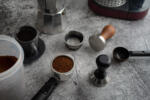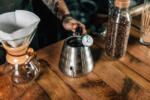Hello, coffee enthusiasts and curious minds! Today, we’re diving into the aromatic world of coffee—a world that has enchanted our senses for centuries.
The alluring fragrance of coffee is a significant part of the coffee experience, and it’s not just about enjoying a delicious cup of brew. It’s about the intricate science behind the aroma and how it plays a role in our perception of flavor.

So, sit back, take a deep breath, and let’s explore the secrets of coffee’s fragrant allure.
From Green Bean to Aromatic Elixir: The Transformation of Coffee Aromas
The Humble Beginnings: Green Coffee Beans
The journey to aromatic coffee begins with green coffee beans, the seeds of the Coffea plant. These raw beans are packed with chemical compounds but don’t yet have the characteristic coffee aroma. In fact, green coffee beans smell more grassy and earthy, and it’s not until they’re roasted that they transform into the fragrant beans we know and love.
The Magic of Roasting: Unleashing the Aroma
The process of roasting coffee beans is where the magic happens. As the beans are heated, they undergo a series of chemical reactions, including the Maillard reaction, which produces a wide array of new aromatic compounds. Roasting also results in the release of volatile compounds that contribute to the enticing fragrance of coffee. The length and temperature of the roasting process significantly impact the aroma profile, allowing roasters to create different sensory experiences.
Coffee Aroma Compounds: A Symphony of Scents
Did you know that coffee is one of the most chemically complex foods we consume? It contains over 800 volatile compounds that contribute to its aroma. These compounds include aldehydes, ketones, pyrazines, and furans, each playing a unique role in the symphony of scents. From fruity and floral to nutty and spicy, the diversity of coffee aromas is truly astounding.
The Sensory Experience: How We Perceive Coffee Aroma
The Olfactory System: Our Gateway to Aroma
The sense of smell is a key player in our experience of coffee aroma. Our olfactory system, which includes receptors in our nose and the olfactory bulb in the brain, detects aroma molecules and helps us identify and appreciate the nuances of coffee’s fragrance. Smell is also closely linked to taste, and together, they create the overall flavor perception.
Coffee Aromas and Memory: The Proustian Effect
The link between aroma and memory is a powerful one. Certain coffee aromas can evoke memories and emotions, a phenomenon known as the Proustian effect. Whether it’s the comforting scent of your grandmother’s kitchen or the invigorating aroma of a bustling coffee shop, coffee fragrances can transport us to different times and places.
Brewing the Perfect Aroma: Techniques and Tips
The Art of Extraction: Dissolving Aromas into the Brew
Brewing coffee is an art and science that involves extracting the flavorful and aromatic compounds from the ground beans. Several factors influence the extraction process, including water temperature, grind size, brewing time, and method. Each brewing technique, from pour-over to espresso, offers a unique way to craft the perfect aroma.
Coffee Freshness: The Key to Vibrant Aromas
To enjoy the full spectrum of coffee aromas, freshness is key. Coffee beans begin to lose their freshness and aroma soon after roasting due to oxidation. To preserve the vibrant scents, it’s best to store coffee beans in an airtight container, away from heat and light, and grind them just before brewing. Freshly ground coffee releases a burst of aromatic compounds, enhancing the sensory experience.
The Impact of Water: A Crucial Ingredient
The quality of water used to brew coffee has a significant impact on its flavor and aroma. Ideally, water for brewing coffee should have a balanced mineral content, as both overly hard and overly soft water can lead to undesirable flavors. Additionally, the ideal temperature for brewing coffee is generally between 195°F (91°C) and 205°F (96°C)—hot enough to extract the compounds but not so hot that it over-extracts and creates bitter flavors.
The Health and Environmental Aspects of Coffee Aromas
Caffeine and Antioxidants: A Double Perk
While caffeine is the star of the show when it comes to coffee’s health effects, there’s more to the story. Coffee is also rich in antioxidants that can help neutralize harmful free radicals and reduce inflammation. Research suggests that regular coffee consumption may lower the risk of certain diseases, such as Parkinson’s and type 2 diabetes. However, individual responses to coffee can vary, so it’s important to listen to your body and consult with a healthcare professional for personalized advice.
Coffee’s Carbon Footprint: Brewing Sustainably
The coffee industry has a significant environmental impact, from deforestation to water use and carbon emissions. By choosing ethically sourced coffee and employing sustainable brewing practices, we can minimize the carbon footprint of coffee production and contribute to a more sustainable future for the industry and coffee-producing communities worldwide.
The Endless Allure of Coffee Aromas: A Journey of Discovery
The world of coffee aromas is a fascinating one, filled with science, art, and sensory delight. From the chemistry of roasting to the brewing techniques that extract the scents, each step of the coffee journey is a chance to explore and savor the diverse fragrances of this beloved beverage.
As we raise our mugs to the captivating world of coffee aromas, we’re reminded that coffee is more than just a drink—it’s a sensory experience that connects us to cultures, memories, and moments. Whether you’re a coffee connoisseur or a curious newcomer, there are always new aromas to discover and enjoy.
Thank you for joining us on this aromatic adventure. May your next cup of coffee be filled with delightful fragrances and the joy of exploration.
Note: The information in this article is based on a variety of sources, including scientific literature and industry knowledge. It is intended for informational and educational purposes only and should not be construed as medical or professional advice. Always consult with a qualified healthcare provider or coffee expert for personalized guidance.
Disclaimer: This post contains affiliate links, which means I may receive a small commission, at no extra cost to you, if you make a purchase using these links. Remember to support us by purchasing through the Amazon/Walmart/Impact Radius links provided. Last update on 2024-04-20 / Affiliate links / Images from Amazon Product Advertising API
Disclosure: No compensation or free products were received in exchange for writing this review.

Editorial Staff
The editorial staff at Crazy Coffee Crave is a team of coffee enthusiasts & Baristas who enjoy the one thing we all think about as soon as we get up in the morning. Trusted by thousands of readers worldwide.





